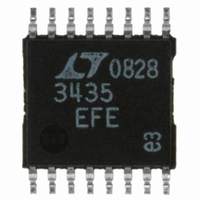LT3435EFE#PBF Linear Technology, LT3435EFE#PBF Datasheet - Page 14

LT3435EFE#PBF
Manufacturer Part Number
LT3435EFE#PBF
Description
IC REG SW HV 3A 500KHZ 16-TSSOP
Manufacturer
Linear Technology
Type
Step-Down (Buck)r
Datasheet
1.LT3435EFEPBF.pdf
(24 pages)
Specifications of LT3435EFE#PBF
Internal Switch(s)
Yes
Synchronous Rectifier
No
Number Of Outputs
1
Voltage - Output
1.25 ~ 54 V
Current - Output
3A
Frequency - Switching
500kHz
Voltage - Input
3.3 ~ 60 V
Operating Temperature
-40°C ~ 125°C
Mounting Type
Surface Mount
Package / Case
16-TSSOP Exposed Pad, 16-eTSSOP, 16-HTSSOP
Primary Input Voltage
60V
No. Of Outputs
1
Output Voltage
68V
Output Current
2.4A
No. Of Pins
16
Operating Temperature Range
-40°C To +125°C
Msl
MSL 1 - Unlimited
Rohs Compliant
Yes
Lead Free Status / RoHS Status
Lead free / RoHS Compliant
Power - Output
-
Available stocks
Company
Part Number
Manufacturer
Quantity
Price
LT3435
APPLICATIO S I FOR ATIO
14
3. Decide if the design can tolerate an “open” core geom-
4. After making an initial choice, consider the secondary
Short-Circuit Considerations
The LT3435 is a current mode controller. It uses the V
node voltage as an input to a current comparator which
turns off the output switch on a cycle-by-cycle basis as
this peak current is reached. The internal clamp on the V
node, nominally 2.2V, then acts as an output switch peak
current limit. This action becomes the switch current limit
specification. The maximum available output power is
then determined by the switch current limit.
A potential controllability problem could occur under
short-circuit conditions. If the power supply output is
short circuited, the feedback amplifier responds to the low
output voltage by raising the control voltage, V
peak current limit value. Ideally, the output switch would
be turned on, and then turned off as its current exceeded
the value indicated by V
time involved in both the current comparator and turn-off
of the output switch. These result in a minimum on time
t
(V
voltage drop, the potential exists for a loss of control.
Expressed mathematically the requirement to maintain
control is:
ON(MIN).
F
etry like a rod or barrel, which have high magnetic field
radiation, or whether it needs a closed core like a toroid
to prevent EMI problems. This is a tough decision
because the rods or barrels are temptingly cheap and
small and there are no helpful guidelines to calculate
when the magnetic field radiation will be a problem.
things like output voltage ripple, second sourcing, etc.
Use the experts in the Linear Technology’s applications
department if you feel uncertain about the final choice.
They have experience with a wide range of inductor
types and can tell you about the latest developments in
low profile, surface mounting, etc.
f t
+ I • R), the diode forward voltage plus inductor I • R
•
ON
When combined with the large ratio of V
≤
V
F
V
+
IN
I R
•
U
C
. However, there is finite response
U
W
U
C
, to its
IN
to
C
C
where:
If this condition is not observed, the current will not be
limited at I
higher value. Using the nominal LT3435 clock frequency
of 500kHz, a V
maximum t
116ns, an unacceptably short time.
The solution to this dilemma is to slow down the oscillator
to allow the current in the inductor to drop to a sufficiently
low value such that the current doesn’t continue to ratchet
higher. When the FB pin voltage is abnormally low thereby
indicating some sort of short-circuit condition, the oscil-
lator frequency will be reduced. Oscillator frequency is
reduced by a factor of 4 when the FB pin voltage is below
0.4V and increases linearly to its typical value of 500kHz at
a FB voltage of 0.95V (see Typical Performance Character-
istics). In addition, if the current in the switch exceeds 1.5
• I
the next on cycle effectively reducing the oscillator fre-
quency by a factor of 2. These oscillator frequency reduc-
tions during short-circuit conditions allow the LT3435 to
maintain current control.
SOFT-START
For applications where [V
large input surge currents can’t be tolerated, the LT3435
soft-start feature should be used to control the output
capacitor charge rate during start-up, or during recovery
from an output short circuit thereby adding additional
control over peak inductor current. The soft-start function
limits the switch current via the V
constant voltage ramp rate (dV/dt) at the output capacitor.
A capacitor (C1 in Figure 2) from the C
regulated output voltage determines the output voltage
PK
f = switching frequency
t
V
V
I • R = inductor I • R voltage drop
ON
F
IN
current demanded by the V
= diode forward voltage
= switch on time
= Input voltage
PK
ON
but will cycle-by-cycle ratchet up to some
to maintain control would be approximately
IN
of 12V and a (V
IN
/(V
OUT
C
F
pin, the LT3435 will skip
+ I • R) of say 0.7V, the
+ V
C
pin to maintain a
F
)] ratios > 10 or
SS
pin to the
3435fa













